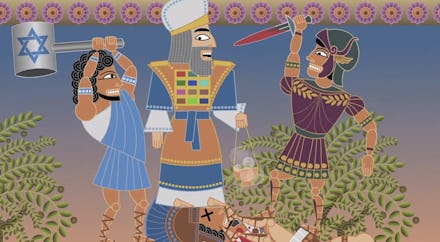One Animated Video Perfectly Explains the Complicated History of Israel and Palestine

The news: The news streaming out of the Gaza Strip has gone from bad to worse after weeklong attacks continue between Israel and Hamas militants. With no ceasefire on the horizon, the death toll is rising.
This isn't a new crisis — Israel-Palestine is very much a centuries-old cycle of conflict, with a complex cycle of problems that is constantly repeating. That cycle is the focus of a 2012 animated short from writer Nina Paley that is trending amidst Gaza's current turmoil. In it, Paley depicts the long history of war fought over territorial claims to a piece of land. And though a bit shocking, the video's satirical tone pinpoints that while a "this land is mine" war is waged, lives are at stake.
The video at first glance is startling and the use of humorous animation is galling, but the message is important: This historical loop of fighting, ingrained with intricate layers, has affected and will continue to affect the lives of many for a long time to come.
History is repeating itself: As ongoing rockets and missiles continue from both sides, the scene is grimly similar to the recent past. Israel's Operation Protective Edge is reminiscent of Operation Cast Lead in the winter of 2008-09 and 2012's Operation Pillar of Defense, particularly in terms of intent.
In each of these scenarios, Israel's offensive was aimed at quelling "the Islamist movement's capabilities," according to the Washington Post. The temporary disruption of Hamas activities, known in Israel as "mowing the lawn," previously succeeded in gaining some time of relative calm, while Hamas expanded their arsenal.
The 2000s were fraught with violence, including the 2006 Lebanon war, where Israel and Hezbollah engaged in a 66-day conflict with a maelstrom of rockets, and the Second Intifada, which resulted in more than 4,000 deaths.
A deep-rooted history of upheaval: As early as the first century CE, ancient Israel, which was predominantly Jewish at the time, was the site of the Jewish-Roman wars that brought in an influx of Christians in its wake.
Muslims flocked to the area between the seventh century on up until the 20th century. This dynamic shift induced conflict and territorial disputes over the "Holy Land" between Christians and Muslims during 1096 and 1291.
Partly because of the persecution of Jews in the late 19th century throughout Europe and Russia, Jews sought out refuge in the area, fueling rising tensions between Jews and Arabs. This gave way to the Nakba the Arabic word for "catastrophe," refering to the events of 1948 that saw some 750,000 Palestinians expelled from what is now Israel, in what many call an act of ethnic cleansing which created the Jewish state. This was followed by the Arab-Israeli War of 1948 after the United Nations announced the state of Israel's independence. More Jews from North Africa and the Middle East fled in the aftermath.
In the subsequent years, pandemonium ensued. There was the 1967 Six-Day War, the 1982 Lebanon invasion, the First Intifada in 1987, the Second Intifada in 2000, the creation of the West Bank barrier in 2005 and the 2006 Lebanon war.
A glance back at the territory's history, and it's clear that it is clash-laden. Paley's video then is extremely apropos. Because though the narrative brings to the forefront an unsettling idea, it is an essential one: Time and time again, a territorial war brings with it thousands of deaths. Now equipped with this knowledge of a revolving loop happening in modern day, the hope is that we can break the cycle and forge a new approach to settle our differences.